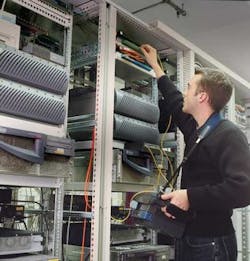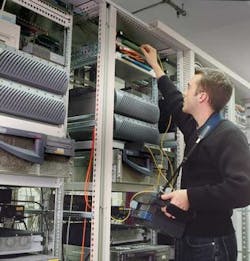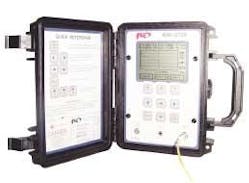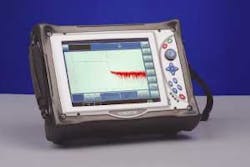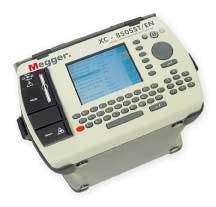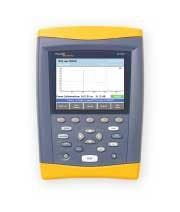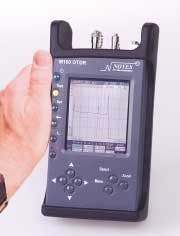With fiber-to-the-home driving OTDR technology comes the promise of higher resolution, less expensive, smaller, and easy-to-use instruments.
The optical time-domain reflectometer (OTDR) is the preferred instrument for evaluating a single optical fiber or complete link. Due to the volume of optical-fiber cabling now in the premises and residential markets, and the growing number of installers, maintenance contractors, and end users needing optical test equipment, OTDR manufacturers are offering a wide range of options, prices, and sizes. (See table of companies and their products, page 38.)
"The premises market hasn't been big enough to significantly impact OTDR technology, but with fiber-to-the-home potentially reaching $100 million a year in new business, the ability to see events on a fiber a few feet or meters apart is more critical than ever," says Peter Schweiger, business development manager for Agilent Technologies. "With fiber-to-the-home driving technology, the premises contractor will benefit over the next three years from higher resolution, less expensive, smaller, and easy-to-use OTDRs."
Made to order
When investing in optical-fiber test equipment, many buyers consider the future benefits of a modular OTDR system with scalable multi-functionality. "People today choose cell phones that are also cameras, pagers, PDAs, and mp3 players, and some also want their OTDRs to do more," says Schweiger. "They may want a power meter and light source, bi-directional loss measurements, or dual wavelength capabilities integrated into one unit, especially if they play in the premises and in the cable TV or telco markets."
In October 2003, Corning Cable Systems introduced a new optical testing platform with modular multi-functionality. The Model 500 Optical Multitester incorporates all applications required for physical layer fiber testing into an expandable platform, including optical spectrum analysis for dense wavelength division multiplexing (DWDM) installations, chromatic dispersion, polarization modal dispersion, visual fault locator, talk set, optical return loss, video inspection probe for examining connectors, and even a 10/100/1000 Ethernet module for testing copper and optical Ethernet systems.
"The Multitester is a product for all markets," says David Hall, marketing manager for private networks, Corning Cable Systems. "Installers can purchase a lower-priced platform with OTDR capabilities and add modules as they move into testing higher-end systems. While it's extremely diverse, the Multitester is also easy to use, with one-button auto testing that automatically evaluates the fiber, saves the information, and advances to the next file."
The tester is available with two, four, or six bays. The two-bay Multitester weighs 14 lbs. and includes a 10.4-inch high-resolution (1024 × 768) LCD color touchscreen and comprehensive help system. "The Multitester utilizes a Pentium processor and Windows-based software, providing the fastest processing of data and the same operability as any PC," explains Sean Pons, Corning Cable Systems' product manager for test equipment. "The Multitester can be connected to the Internet, to a network, and to USB and serial devices, and its CD burner means up to 30,000 results and software can be stored on one CD."
The Multitester ranges from $18K up to over $60K depending on how it's ordered. "For the premises LAN market, we recommend purchasing the Multitester with singlemode and multimode modules, a visual fault locator, and light source and power meter," says Pons. "That version is priced around $28K, but because this is a high-end unit, many people want to take advantage of its full capabilities."
Slightly smaller than the Multitester, the 6.4-lb. E6000C Mini-OTDR from Agilent Technologies is also based on a modular multi-functionality design. The E6000C is available with single- (economy) and dual-wavelength (high performance) modules for singlemode and multimode testing, as well as optical power meter and visual fault locator modules. The unit features a 3.5-inch floppy disk drive and 440 MB memory card capable of storing 13,000 traces.
E6092A Toolkit software available with the E6000C offers contractors an advantage when testing high fiber counts. "Instead of tediously loading, testing, and evaluating one fiber at a time, our software lets installers load an entire cable as a project, taking hours of analysis down to seconds," says Schweiger. With its multifiber test function, the E6000C tests, saves, and automatically increments to the next fiber; once the data is loaded onto a PC, the software wizard checks the data, organizes it into a project, and creates reports.
"A check sum on an OTDR trace cannot be duplicated—it's like a snowflake," says Schweiger. "Our software also checks all traces to make sure there have been no duplications, either by accident or intentionally." The E6000C ranges from $8K to $27K, averaging around $10K. The E6092A Toolkit software is priced at $1,700, but a free version with 75% functionality is available at www.otdor.com.
Easy on the pocket
Fiber Instrument Sales (FIS) manufactures a low-cost mini-OTDR that the company says is ideal for field installation and maintenance. "Other OTDRs can be intense, and we originally designed the FIS Mini-OTDR for the user who may be new to maintaining a fiber network," says Don Biron, test equipment product manager. "Due to its small size, we've seen this become very popular for a full range of field work, including metro applications."
The FIS Mini-OTDR is 8 × 6 inches and weighs 2 lbs. It comes in a LAN version for up to 16 km, and Metro version for up to 64 km. Both are available with dual and single wavelength in multimode or singlemode versions. With 255 traces stored in RAM, the RS-232 port can be used to print or download the information to a PC.
"Our Windows-based batch download software lets installers respond to the fact that 90% of engineers require an OTDR test with an electronic or hard-copy version of traces," says Biron. "As the cost of components comes down, we can improve the Mini-OTDR by adding other options and still keep the product in the price range of our customers." The single wavelength FIS Mini-OTDR is currently $4,900, and the dual wavelength is $5,900.
Designed for the LAN installer or technician with maximum fiber lengths of 2 km, the dual wavelength XC-8513 OTDR is a recent launch from Megger. It is capable of measuring multimode duplex cable with one connection. "Traditional OTDRs had one connector, but ours can measure the transmit-and-receive fibers at the same time," says PJ McGee, sales engineer. "The unit switches the wavelength internally and saves the results as a tagged pair to eliminate confusion, which is ideal when testing many duplex connectors."
The XC-8513 uses smart-card technology to store more than 10,000 traces and features a 5-button task list that changes from red to green as each task is performed. "An engineer can set parameters on the smart card, send a technician who isn't even fiber-savvy out into the field, and the unit reads the smart card and guides the technician through the process to ensure that all required tests are completed," explains McGee. He says the XC-8513 features some of the best performance specifications in the industry, with a less than 2-meter event dead zone at 850 nm. The fully loaded XC-8513 is available for under $8,500, weighs 10.8 lbs., and is 5.5 × 8.5 inches. A singlemode version is under development.
Wilcom's FiberRanger3, a lightweight mini-OTDR in a rugged enclosure, is available in single and dual wavelengths and multimode and singlemode versions. The FiberRanger3 features a 1/4 VGA monochrome display that shows fiber loss versus distance, and parameters such as index of refraction, pulse width, and scanning speed. The FiberRanger3 lists for $4,950 for single wavelength and $5,950 for dual.
"There's a lot of competition in fiber test equipment, and we're geared to the contractor looking for a cost-effective OTDR with basic functions," says John Adams, Wilcom's marketing service manager. "We wouldn't want to try to compete with the big players."
Handheld hype
The Noyes M100-Quad OTDR by AFL Telecommunications is one of the first handheld singlemode and multimode four-wavelength OTDRs with integrated visual fault locator. The M100 is based on PDA technology and is equipped with a 16-MB CompactFlash card able of storing more than 300 traces. The multimode and singlemode OTDR ports are equipped with tool-less, switchable adapter mounts for the ST, SC, and FC-type connectors that come with the product.
"We've generally stayed away from modular products and focus on solutions with dedicated functions, making them as small and as inexpensive as possible," says Chris Blair, product development manager with AFL Telecommunications. The 2.7-lb. M100 is 7.5 × 4 × 2.75 inches; the quad version lists for $9K while the singlemode- and multimode-only versions list for about $6K.
Fluke Networks has also entered the handheld OTDR market with their OptiFiber Certifying OTDR. "The OptiFiber is based on the same concept of our copper cable certifiers, driven by the need for installers to show test results to industry standards in order to receive vendor warranties," says Eric Anderson, marketing manager. "The OptiFiber records insertion loss, fiber length, and polarity, and reports whether the link is pass or fail as required by TIA/EIA-TSB-140 Tier 1 testing."
The OptiFiber includes a library of global standards, and with LinkWare data management and reporting software, installers can manage the data and create reports for their customers. It connects to a PC, or data can be stored on the multimedia memory card.
"The OptiFiber is small but offers modularity with dual-wavelength singlemode and multimode modules, as well as the loss link certification module with light source and power meter," says Anderson. "Without the loss link certification module, a separate power meter and light source is required to manually perform Tier 1 testing requirements."
Designed specifically for the premises market with short fiber lengths and precise measurements, the OptiFiber weighs 4.5 lbs. and includes a camera port for checking connectors with Fluke's Fiber Inspector. The OptiFiber with multimode module is about $14K, with singlemode about $12K. The loss link module is an additional $1,500.
Last month, Fluke Networks announced the availability of OptiFiber Smart Remote, which it calls an intelligent remote device that complements the OptiFiber's test capabilities. OptiFiber Smart Remote addresses the insertion-loss certification requirement of compatible test equipment at both ends of the link under test. Users can, with one button push, launch an automated insertion-loss autotest that includes five optical measurements—two wavelengths, on two fibers, plus optical length—as well as link analysis. The Smart Remote has a list price of $4,995, including the remote unit and one multimode adapter module. Singlemode and multimode modules are available separately at prices starting at $1,995.
Performance counts
Among the several options, prices, and sizes available, manufacturers continue to improve OTDR performance, which is typically based on event and attenuation dead zones and dynamic range. "Buyers need to be aware that they don't mistake event dead zones with attenuation dead zones,"explains Agilent's Schweiger. "Dead zones also vary based on the height of reflection, wavelength, and pulse size."
As manufacturers strive to reduce event and attenuation dead zones, OTDR performance is still influenced by ease of use and the user. "You have to be able to use the OTDR, and manufacturers are trying to make that as transparent as possible," says Schweiger. "It also helps when you use the product more often. Installers get to know OTDRs because they see them more than their wives, whereas maintenance contractors and end users using them for troubleshooting only require OTDRs that are easy to use."
Betsy Ziobron is a freelance writer and regular contributor to Cabling Installation & Maintenance. She can be reached at: [email protected]
Please click here to download Product Update: OTDRs as .pdf {pdf size= 43KB}.
